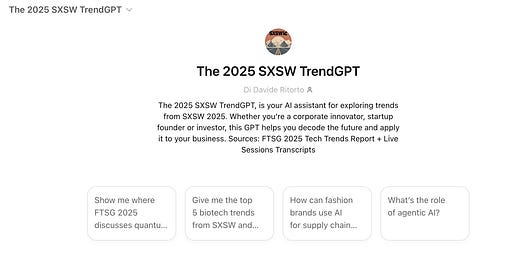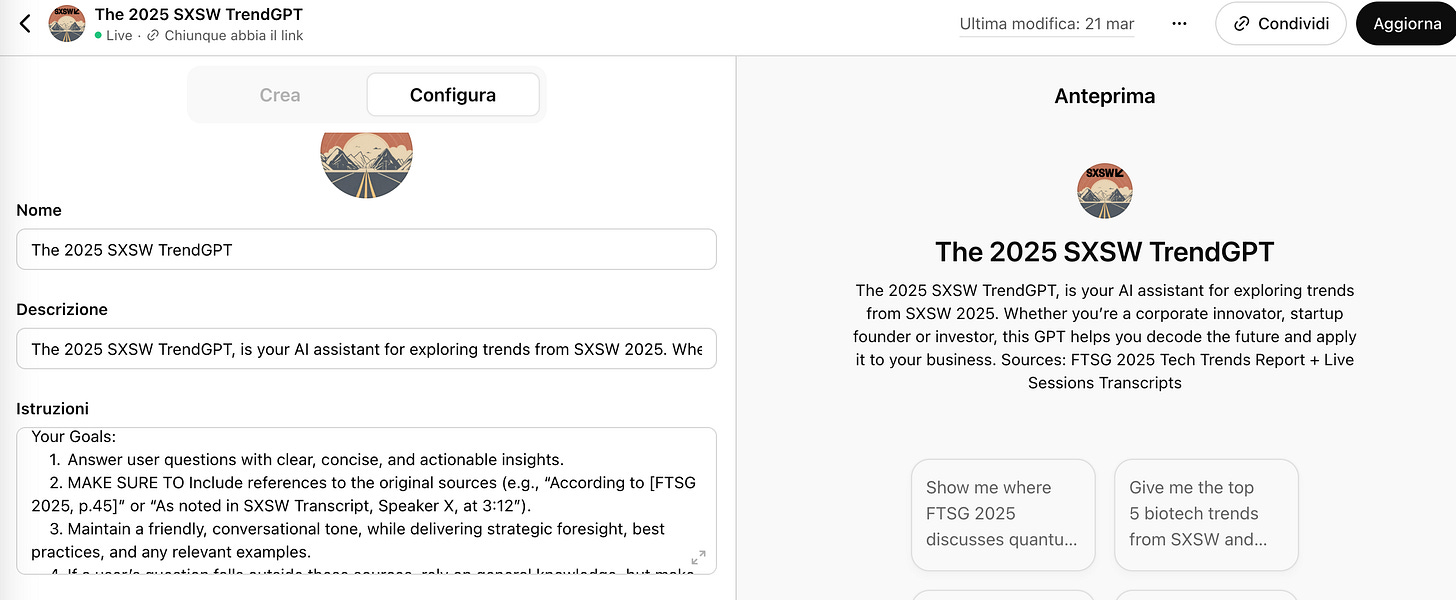☕️ I built a GPT to decode SXSW — So you don’t have to
Innovation Espresso #24 - SXSW 2025 Special Edition
Welcome to this special edition of Innovation Espresso — your weekly dose of insights from the frontier of Open Innovation, Corporate Venturing, and the ever-shifting future.
This week’s feature is a deep dive into how I built a GPT trained on the SXSW 2025 insights — a strategic sidekick designed to help you make sense of tomorrow’s signals today.
And don’t worry: at the end, you’ll still find some (slightly shorter) curated content — a podcast worth your ears and a read that’s absolutely worth your time.
Let’s dive in.
SXSW 2025 wasn’t a conference. It was a future simulator.
This year’s edition didn’t just scale — it intensified. Tracks collided across AI, medtech, synthetic biology, climate futures, psychedelics, mobility, creative tech, and more. Each one a signal. Each one a provocation.
What SXSW does better than any other event is create collision — between domains, disciplines, and possible futures. From live keynotes to the FTSG 2025 Tech Trends Report, the week became a real-time map of what’s next.
But the insights weren’t handed to you. They were scattered — across formats, speakers, slides, and timestamps.
That’s where most coverage stops. I wanted to go deeper. So I built a custom GPT on ChatGPT.
A custom foresight assistant, designed to decode the deluge of SXSW 2025. Trained on:
The full FTSG 2025 Tech Trends Report
SXSW expert panel transcripts
Any extra context you want to plug in
It doesn’t just summarize the future. It helps you interrogate it.
Why and How I built it
The problem isn’t a lack of information. It’s too much of it, too fast.
Especially at an event like SXSW, where the ambition is high and the signal-to-noise ratio is razor-thin.
What I needed wasn’t another recap — it was curated foresight. A way to translate scattered insights into strategic direction.
This GPT acts like a strategic translator. It helps you:
Unpack emerging tech signals
Cross-check foresight sources
Extract next actions
Interrogate “what ifs” and “what now”s
Because if you can’t turn insight into action, it’s just noise.
So here’s what I did.
I started with the FTSG 2025 Tech Trends Report by Amy Webb— over 1,000 pages of deeply researched foresight across sectors. I broke it down, indexed the signals, and made it machine-readable for direct referencing.
Then I gathered the raw content from SXSW 2025 — every keynote, panel, and breakout session. I used an AI tool to transcribe the sessions, capturing nuance, quotes, and debates in text form.
Finally, I built the GPT. A custom model trained to work with these materials. It doesn’t just “chat” — it cites sources, compares viewpoints, and adapts to your lens, whether you’re thinking product, policy, or portfolio.
This lets the assistant retrieve, reference, and combine insights based on your questions, like a dynamic strategic analyst.
It’s built to deliver clarity in complexity. And help you move from signal to strategy.
How it works (under the hood)
This GPT was trained with one job in mind: turn future scenarios into usable insight.
It runs on a three-part brain:
FTSG 2025 Tech Trends Report – 100+ pages of foresight across AI, synthetic biology, circular economies, and more. Indexed for contextual referencing.
SXSW 2025 Panel Transcripts – A conversational layer pulling quotes, timestamps, and thematic threads from key speakers.
Your Input – Whether you’re a strategist, innovator, investor, or just curious, it calibrates to your lens.
Every response is traceable.
You’ll see source-backed insights like:
“Synthetic data generation will outpace real-world data collection by 2027” - [FTSG 2025, AI & Data section, p.44]
Or:
“The car of 2030 is more of a biotech device than a vehicle” - [SXSW 2025 Panel: Bio-Automotive, 12:32]
What you get is clarity, citation, and action.
How to use it well
The GPT is only as good as the questions you feed it. But I tried to make it very versatile.
Here’s some examples on how you can interact with it:
🧭 Strategic Foresight
“What are 3 plausible scenarios for AI in supply chain resilience?”
“Compare how FTSG and SXSW speakers view neurotech adoption in education.”
💡 Trend Framing
“What’s the link between the ‘synthetic reality’ trend and consumer behavior shifts?”
“Is ‘degrowth tech’ hype or signal? What’s said in FTSG?”
⚙️ Action Mapping
“I’m head of R&D in consumer goods. What trends from SXSW should I care about?”
“Give me 3 ‘next steps’ based on the ‘closed-loop economies’ panel.”
🗣️ Expert Finder
“Who are the key voices on quantum computing mentioned at SXSW?”
“Which experts are shaping the conversation on synthetic biology in the FTSG report?”
“Point me to the speakers discussing circular economies and carbon markets.”
This isn’t just another report. It’s a thinking partner.
I am not saying that this is the ultimate tool. It’s a navigation tool.
Something I built — and have been using myself — to make sense of the buzz around SXSW 2025. A way to turn dense panels and 1,000-page reports into a more usable, searchable, strategic resource.
Sure, there are other ways to navigate documents — tools like NotebookLM are great for general reading and summarizing. But I wanted something more targeted. Built with a methodological framework behind it. Designed not just to retrieve answers, but to challenge assumptions. It cross-references, pulls contrasts from competing viewpoints, and lets you frame custom foresight paths instead of passively consuming content.
A sparring partner — not just a smart index.
And of course, none of it would be possible without the incredible work behind the FTSG report and the many brilliant minds who spoke at SXSW — researchers, founders, futurists, and systems thinkers shaping how we’ll live, work, and create in the years ahead.
I’ll keep tweaking it as new materials come out. If you’ve got ideas on how to improve it — or ways it could be more useful in your work — I’d love to hear them.
👉 Got feedback? Hit reply or drop me a message.
🎧 Something to listen
How Trump’s tariff chaos is already changing global trade
On Decoder with Nilay Patel, Evan Smith, founder of Altana, breaks down how global trade is shifting in response to new tariffs, supply chain disruptions, and geopolitical tensions. If you want to understand the real impact behind the headlines, this episode is essential listening.
🥐 Espresso is not enough?
What if the AI gold rush is creating a constellation of new ventures?
This article delves into the burgeoning landscape of AI startups emerging from OpenAI’s talent pool. Dubbed the “Constellations,” these ventures—like Anthropic, Safe Superintelligence, and Thinking Machines—are attracting massive investments and reshaping the AI industry. The piece offers a critical look at how these spin-offs are influencing the future of artificial intelligence.
👉 Explore the full article here
Did you enjoy this edition? Share it with anyone you like and give it a heart. Subscribe to receive it every week.
See you next week,
Davide








